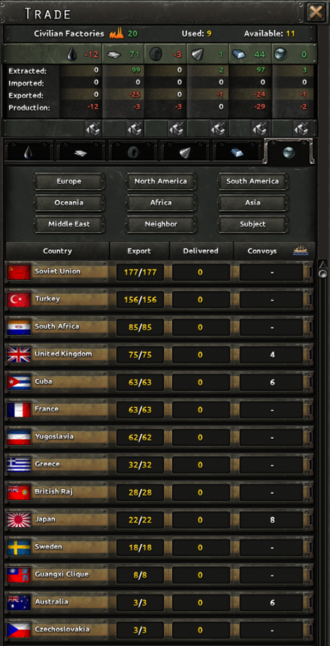无编辑摘要 |
小 (文本替换 - 替换“{{flag|”为“{{国旗|”) |
||
| (未显示3个用户的5个中间版本) | |||
| 第1行: | 第1行: | ||
{{Version|1.9}} | {{Version|1.9}} | ||
[[File:Trade screen.png|thumb|330px| | [[File:Trade screen.png|thumb|330px| 贸易界面]] | ||
'''Trade''' | '''贸易'''(英文:'''Trade''' )是指国家之间的资源交换,包括使用[[ 建设#民用工厂|民用工厂]] 交易所得的[[ 生产#战略资源|战略资源]] 。 | ||
== | == 战略资源出口== | ||
{{SVersion|1.9}} | {{SVersion|1.9}} | ||
根据一个国家的[[ 法律与顾问#贸易法案|贸易法案]] ,将其国内战略资源生产的一部分出口到全球市场。这些资源无法由出口国使用,无论这些资源是否已达成贸易协议。该机制用于抽象变化的资源生产级别。 | |||
如果出口的战略资源没有与他国达成贸易协议,那么它将不会被使用,并且仍将供全球市场使用而无法存储该资源。您可以使用民用工厂进行战略资源贸易。 | |||
贸易对战略和军事计划有重大影响。由于专门用于出口的战略资源部分是由[[法律与顾问#贸易法案|贸易法案]]确定的,因此选择正确的法律至关重要。在理想的世界中,一个国家会完全保留自己所需要的战略资源,并将多余的部分出口给外国以增加产量。在事实中,贸易法案会将固定比例的出口资源以及来自贸易的附带加成设定为工厂产出增加,建造速度和科研速度。 | |||
== | 在这些贸易法案中,'''封闭经济法案'''没有这些好处,但会保留其所有战略资源用于自己的生产。而在另一个极端,'''自由贸易法案'''可以使出口国中80%的战略资源用于出口。由于对不同战略资源的需求不同,同一国家可能在不同时间受益于不同的法案。 | ||
== 进行贸易 == | |||
{{SVersion|1.9}} | {{SVersion|1.9}} | ||
一个国家可以与任何非敌对国家达成贸易协议,提供可出口的战略资源。出口国无需批准贸易协议,也不会收到已达成贸易的通知。 | |||
进口国将需要花费至少1个 {{icon|civilian factory}} 民用工厂作为进口成本。如果市场上有售,每个 {{icon|civilian factory}} 民用工厂将允许最多进口8个单位的单种战略资源。即使出口国无法出口8个单位的战略资源,那么进口国仍将需要花费1个 {{icon|civilian factory}} 民用工厂来交易所剩的不足8个单位的战略资源。 | |||
从[[ 傀儡国]] 进口战略资源时,每80个单位的战略资源宗主国仅需花费1个 {{icon|civilian factory}} 民用工厂。在启用 {{icon|tfv}} [[ 共赴胜利]] DLC后,上述内容也适用于殖民地(50%)和自治领(25%)。因此,在这种情况下,1个民用工厂可以分别交易80个单位,16个单位和10个单位的战略资源。启用 {{icon|lar}} [[ 抵抗运动]] DLC后,宗主国下属的合作政府也将为每个 {{icon|civilian factory}} 民用工厂提供80个单位的战略资源。 | |||
交易所得的[[ 生产#战略资源|战略资源]] 将添加到进口国内,这意味着进口国将可用这些战略资源进行[[ 生产]] 。 | |||
== | == 贸易影响 == | ||
{{SVersion|1.9}} | {{SVersion|1.9}} | ||
某个国家可能从一个国家进口的战略资源量取决于潜在进口国的贸易影响力。 | |||
贸易影响力将影响该进口国进口战略资源的百分比,因这意味着,如果一个国家有60点贸易影响力,而另一个国家有40点贸易影响力,则前者可以获得的资源为60%,而后者可以进口40%。另外,如果第三个具有100点贸易影响力的国家想要进口战略资源,他们将被允许进口50%的资源,而前两个国家现在将只能分别进口30%和20%的资源。 | |||
如果贸易影响力为0,则一个国家可能不再从该国家进口资源,但是通常只有在这两个国家相互之间发生战争或通过[[ 国策]] 贸易禁运特定国家时才会发生。 | |||
贸易影响力的变化取决于许多因素: | |||
* | * 基础值为150。 | ||
* | * 两国之间的距离。 | ||
* | * 进口国与出口国之间的关系。 | ||
* | * 与出口国具有相同意识形态的政党将提高贸易影响力(威权政体国家除外)。 | ||
* | * 有着大量的接壤边境。 | ||
* | * 在出口国的港口内有大量船只。 | ||
* | * 出口国是进口国的傀儡国或是合作政府。 | ||
* | * 进行作战任务。 | ||
在实际操作中,民用工厂的相对稀缺,大量战略资源的战略重要性以及战争将使贸易影响力在任何情况下都与游戏最初几年没有至关重要的作用。 | |||
== | == 运输战略资源 == | ||
{{SVersion|1.9}} | {{SVersion|1.9}} | ||
陆路贸易是最为优先的。在以下情况下,将使用陆路贸易: | |||
*经过同一阵营盟国和中立国的贸易路线。 | |||
*两国首都之间的距离短于: | |||
:<math> \sqrt { \ln \left ( 2 + \text {国家A的地区数量} + \text {国家B的地区数量} \right ) }</math> | |||
<math> \cdot 1000 \cdot 7{.}114 \text {km}</math> | |||
例如, {{ 国旗|唐努图瓦}} 和 {{ 国旗|卢森堡}} 之间的陆路贸易无法实现,因为他们的首都之间的距离是9917公里,超过了上述公式中的8765公里。以下是该例子的计算过程: | |||
:<math> \sqrt { \ln \left ( 2 + \text {国家A的地区数量} + \text {国家B的地区数量} \right ) }</math> | |||
<math> \cdot 1000 \cdot 7{.}114 \text {km} = \sqrt { \ln \left ( 2 + 1 + 1 \right ) } \cdot 1000 \cdot 7{.}114 \text {km} = </math> | |||
:<math>= \sqrt { \ln \left ( 4 \right ) } \cdot 1000 \cdot 7{.}114 \text {km} = \sqrt { 1{.}38629 } \cdot 1000 \cdot 7{.}114 \text {km} = 1{.}17741 \cdot 1000 \cdot 7{.}114 \text {km} = 8765 \text {km} </math> | :<math>= \sqrt { \ln \left ( 4 \right ) } \cdot 1000 \cdot 7{.}114 \text {km} = \sqrt { 1{.}38629 } \cdot 1000 \cdot 7{.}114 \text {km} = 1{.}17741 \cdot 1000 \cdot 7{.}114 \text {km} = 8765 \text {km} </math> | ||
如果无法进行陆路贸易,将选择两国的1个[[建设#省份建设|海军基地]]作为海上贸易路线。这些海军基地是从距离各自首都最近的10个海军基地中挑选的。然后,这10个最接近的海军基地成为源端口和目标端口的成对组合,并在其中用以下公式进行计算: | |||
:<math>10 \cdot \left ( \text{ 源端口海军基地级别} + \text{ 目标端口海军基地级别} \right ) - \left ( \text{ 距离(公里)} \right ) \div 7{.}114 \div 3 </math> | |||
:<math>10 \cdot \left ( \text{ | |||
上文所选的10种组合经过上述公式计算后,具有最小值的组合确定了海上贸易路线。 | |||
例如, {{国旗|苏维埃联盟}}(距莫斯科最近的10个海军基地)和 {{国旗|日本}}(距东京最近的7个海军基地)之间的海上贸易提供了70条可能的路线,其中大多数需要穿越地中海。其中西伯利亚东北部的海军基地是苏联在亚洲唯一符合条件的海军基地(符拉迪沃斯托克是全世界被排除在外的极少数海军基地之一)。该海军基地与日本最北部的海军基地(属千岛群岛)相连,而日本该海军基地通过多个海峡与首都东京相连。尽管这两个海军基地都位于两国非常偏远的地区,但可以从各自的首都到达该地[[地区]]。 | |||
除了该进行海上贸易的海军基地所处[[ 地区]] 拥有该出口国所进行贸易的战略资源外,以上的方法均适用于进口国所需战略资源的通过首都进行的出口国内转移。 | |||
进口国所进行的海上贸易需要[[后勤#convoys|运输船]],这使得很容易受到敌对国海军的袭击,尤其是潜艇的狩猎。您可以看到运输船队在资源地图模式下走的路线,因此,一个国家可能会使用海军来巡逻必须穿越和保障其战略资源成功运输的海域。海军规模较小的国家最好在附近寻找贸易伙伴,因为这样可以进行陆路贸易,以减少不必要的损失。 | |||
{{Mechanics_Navbox}} | {{Mechanics_Navbox}} | ||
[[ | [[ 分类:Diplomacy]] | ||
[[ | [[en:Trade]] | ||
2022年12月6日 (二) 11:06的最新版本
贸易(英文:Trade)是指国家之间的资源交换,包括使用民用工厂交易所得的战略资源。
战略资源出口
|
|
这部分内容可能已不适合当前版本,最后更新于1.9。 |
根据一个国家的贸易法案,将其国内战略资源生产的一部分出口到全球市场。这些资源无法由出口国使用,无论这些资源是否已达成贸易协议。该机制用于抽象变化的资源生产级别。
如果出口的战略资源没有与他国达成贸易协议,那么它将不会被使用,并且仍将供全球市场使用而无法存储该资源。您可以使用民用工厂进行战略资源贸易。
贸易对战略和军事计划有重大影响。由于专门用于出口的战略资源部分是由贸易法案确定的,因此选择正确的法律至关重要。在理想的世界中,一个国家会完全保留自己所需要的战略资源,并将多余的部分出口给外国以增加产量。在事实中,贸易法案会将固定比例的出口资源以及来自贸易的附带加成设定为工厂产出增加,建造速度和科研速度。
在这些贸易法案中,封闭经济法案没有这些好处,但会保留其所有战略资源用于自己的生产。而在另一个极端,自由贸易法案可以使出口国中80%的战略资源用于出口。由于对不同战略资源的需求不同,同一国家可能在不同时间受益于不同的法案。
进行贸易
|
|
这部分内容可能已不适合当前版本,最后更新于1.9。 |
一个国家可以与任何非敌对国家达成贸易协议,提供可出口的战略资源。出口国无需批准贸易协议,也不会收到已达成贸易的通知。
进口国将需要花费至少1个 ![]() 民用工厂作为进口成本。如果市场上有售,每个
民用工厂作为进口成本。如果市场上有售,每个 ![]() 民用工厂将允许最多进口8个单位的单种战略资源。即使出口国无法出口8个单位的战略资源,那么进口国仍将需要花费1个
民用工厂将允许最多进口8个单位的单种战略资源。即使出口国无法出口8个单位的战略资源,那么进口国仍将需要花费1个 ![]() 民用工厂来交易所剩的不足8个单位的战略资源。
民用工厂来交易所剩的不足8个单位的战略资源。
从傀儡国进口战略资源时,每80个单位的战略资源宗主国仅需花费1个 ![]() 民用工厂。在启用
民用工厂。在启用 ![]() 共赴胜利 DLC后,上述内容也适用于殖民地(50%)和自治领(25%)。因此,在这种情况下,1个民用工厂可以分别交易80个单位,16个单位和10个单位的战略资源。启用
共赴胜利 DLC后,上述内容也适用于殖民地(50%)和自治领(25%)。因此,在这种情况下,1个民用工厂可以分别交易80个单位,16个单位和10个单位的战略资源。启用 ![]() 抵抗运动 DLC后,宗主国下属的合作政府也将为每个
抵抗运动 DLC后,宗主国下属的合作政府也将为每个 ![]() 民用工厂提供80个单位的战略资源。
民用工厂提供80个单位的战略资源。
交易所得的战略资源将添加到进口国内,这意味着进口国将可用这些战略资源进行生产。
贸易影响
|
|
这部分内容可能已不适合当前版本,最后更新于1.9。 |
某个国家可能从一个国家进口的战略资源量取决于潜在进口国的贸易影响力。
贸易影响力将影响该进口国进口战略资源的百分比,因这意味着,如果一个国家有60点贸易影响力,而另一个国家有40点贸易影响力,则前者可以获得的资源为60%,而后者可以进口40%。另外,如果第三个具有100点贸易影响力的国家想要进口战略资源,他们将被允许进口50%的资源,而前两个国家现在将只能分别进口30%和20%的资源。
如果贸易影响力为0,则一个国家可能不再从该国家进口资源,但是通常只有在这两个国家相互之间发生战争或通过国策贸易禁运特定国家时才会发生。
贸易影响力的变化取决于许多因素:
- 基础值为150。
- 两国之间的距离。
- 进口国与出口国之间的关系。
- 与出口国具有相同意识形态的政党将提高贸易影响力(威权政体国家除外)。
- 有着大量的接壤边境。
- 在出口国的港口内有大量船只。
- 出口国是进口国的傀儡国或是合作政府。
- 进行作战任务。
在实际操作中,民用工厂的相对稀缺,大量战略资源的战略重要性以及战争将使贸易影响力在任何情况下都与游戏最初几年没有至关重要的作用。
运输战略资源
|
|
这部分内容可能已不适合当前版本,最后更新于1.9。 |
陆路贸易是最为优先的。在以下情况下,将使用陆路贸易:
- 经过同一阵营盟国和中立国的贸易路线。
- 两国首都之间的距离短于:
- [math]\displaystyle{ \sqrt { \ln \left ( 2 + \text {国家A的地区数量} + \text {国家B的地区数量} \right ) } }[/math]
[math]\displaystyle{ \cdot 1000 \cdot 7{.}114 \text {km} }[/math]
例如, ![]() 唐努图瓦和
唐努图瓦和 ![]() 卢森堡之间的陆路贸易无法实现,因为他们的首都之间的距离是9917公里,超过了上述公式中的8765公里。以下是该例子的计算过程:
卢森堡之间的陆路贸易无法实现,因为他们的首都之间的距离是9917公里,超过了上述公式中的8765公里。以下是该例子的计算过程:
- [math]\displaystyle{ \sqrt { \ln \left ( 2 + \text {国家A的地区数量} + \text {国家B的地区数量} \right ) } }[/math]
[math]\displaystyle{ \cdot 1000 \cdot 7{.}114 \text {km} = \sqrt { \ln \left ( 2 + 1 + 1 \right ) } \cdot 1000 \cdot 7{.}114 \text {km} = }[/math]
- [math]\displaystyle{ = \sqrt { \ln \left ( 4 \right ) } \cdot 1000 \cdot 7{.}114 \text {km} = \sqrt { 1{.}38629 } \cdot 1000 \cdot 7{.}114 \text {km} = 1{.}17741 \cdot 1000 \cdot 7{.}114 \text {km} = 8765 \text {km} }[/math]
如果无法进行陆路贸易,将选择两国的1个海军基地作为海上贸易路线。这些海军基地是从距离各自首都最近的10个海军基地中挑选的。然后,这10个最接近的海军基地成为源端口和目标端口的成对组合,并在其中用以下公式进行计算:
- [math]\displaystyle{ 10 \cdot \left ( \text{源端口海军基地级别} + \text{目标端口海军基地级别} \right ) - \left ( \text{距离(公里)} \right ) \div 7{.}114 \div 3 }[/math]
上文所选的10种组合经过上述公式计算后,具有最小值的组合确定了海上贸易路线。
例如, ![]() 苏维埃联盟(距莫斯科最近的10个海军基地)和
苏维埃联盟(距莫斯科最近的10个海军基地)和 ![]() 日本(距东京最近的7个海军基地)之间的海上贸易提供了70条可能的路线,其中大多数需要穿越地中海。其中西伯利亚东北部的海军基地是苏联在亚洲唯一符合条件的海军基地(符拉迪沃斯托克是全世界被排除在外的极少数海军基地之一)。该海军基地与日本最北部的海军基地(属千岛群岛)相连,而日本该海军基地通过多个海峡与首都东京相连。尽管这两个海军基地都位于两国非常偏远的地区,但可以从各自的首都到达该地地区。
日本(距东京最近的7个海军基地)之间的海上贸易提供了70条可能的路线,其中大多数需要穿越地中海。其中西伯利亚东北部的海军基地是苏联在亚洲唯一符合条件的海军基地(符拉迪沃斯托克是全世界被排除在外的极少数海军基地之一)。该海军基地与日本最北部的海军基地(属千岛群岛)相连,而日本该海军基地通过多个海峡与首都东京相连。尽管这两个海军基地都位于两国非常偏远的地区,但可以从各自的首都到达该地地区。
除了该进行海上贸易的海军基地所处地区拥有该出口国所进行贸易的战略资源外,以上的方法均适用于进口国所需战略资源的通过首都进行的出口国内转移。
进口国所进行的海上贸易需要运输船,这使得很容易受到敌对国海军的袭击,尤其是潜艇的狩猎。您可以看到运输船队在资源地图模式下走的路线,因此,一个国家可能会使用海军来巡逻必须穿越和保障其战略资源成功运输的海域。海军规模较小的国家最好在附近寻找贸易伙伴,因为这样可以进行陆路贸易,以减少不必要的损失。
| 政策 | 意识形态 • 阵营 • 国策 • 内阁 • 政府 • 傀儡国 • 外交 • 全球紧张度 • 内战 • 占领区 • 情报机构 |
| 生产 | 贸易 • 生产 • 建设 • 装备 • 燃料 |
| 科研与科技 | 科研 • 步兵科技 • 辅助部队(支援连)科技 • 装甲车辆科技 • 火炮科技 • 陆军学说 • 海军科技 • 海军学说 • 空军科技 • 空军学说 • 工程学科技 • 工业科技 |
| 军事与战争 | 战争 • 陆军单位 • 陆战 • 编制设计 • Army planner • 集团军 • 指挥官 • 作战计划 • 战术 • 海军单位 • 海战 • 空军单位 • 空战 • 经验 • 损耗与事故 • 后勤 • 人力 • 核弹 |
| 地图 | 地图 • 省份 • 地形 • 气候 • 地区 |
| 事件与决议 | 事件 • 决议 |
